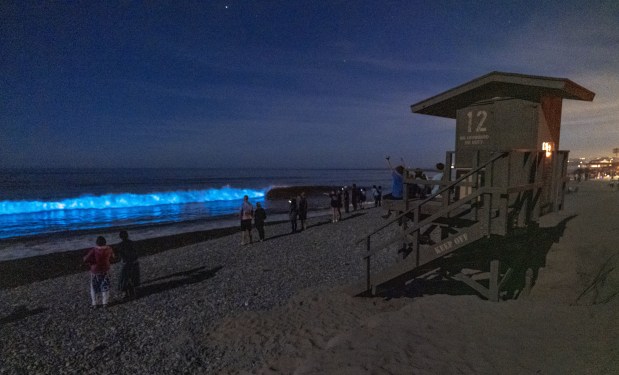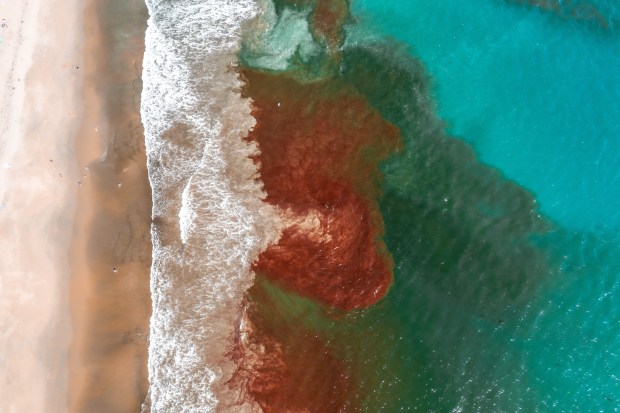
Michael Keith remembers feeling strange, like his equilibrium was off, a few days after taking a dip into the glowing neon water when it showed up off Belmont Shores in Long Beach a few months back.
Some people have reported being itchy after swimming in the bioluminescent waves that put on a show night after night for weeks earlier this year. Some surfers complained of scratch throats, sinus issues and coughing after riding red tide waves that lingered for weeks off Southern California.
Researchers have launched a survey asking people who went to the beach, either getting in the water or watching glowing waves from the sand, during the recent red tide event if they had any notable health issues that potentially could have been caused by the phytoplankton’s presence.
The survey is being conducted by the Surfrider Foundation, the Southern California Coastal Ocean Observing System and researchers at the Scripps Institution of Oceanography. It asks for feedback from anyone who went to the beach in Northern Baja or Southern California between March 30 and May 31.
The idea is to collect anecdotal information on potential respiratory symptoms or other health issues experienced after being exposed. The information collected would be used for future publications and bulletins exploring the impacts of this type of phytoplankton bloom.
The recent red tide in Southern California brought record-breaking counts of Lingulodinium polyedra (L. polyedra), a species of phytoplankton that caused the ocean to turn rusty red during the day, but glow at night for more than six weeks.
There were reports that spanned from Tijuana to Ventura, with large concentrations in areas off San Clemente, Newport Beach, Huntington Beach and the South Bay for weeks, though each day differed on where it could be found.
The bloom of phytoplankton is a natural phenomenon that gets exacerbated by nutrient runoff and warming waters. Heavy rains in March and April brought loads of fresh water along with urban run-off and nutrients to the ocean, and warm water off the coast at the time made for a perfect recipe for the algae bloom.
The type of phytoplankton that makes up red tide blooms varies by region and toxicity. Most are harmless and are essential to the Earth’s oxygen production and marine ecosystem, but others can be harmful to humans and marine life.
The one that showed up off Southern California was a type considered to be less toxic than others, however there have been “anecdotal” reports of respiratory symptoms developing after L. polyedra exposure for years.

So instead of just hearing surfer stories about not feeling well after taking a dip in the glowing ocean or getting hit with the sea spray while watching from shore, researchers actually want to collect more data.
Katie Day, a scientist for San Clemente-based Surfrider Foundation, said she understands the lure the glowing ocean had to some who wanted to splash around in it.
“You can’t not go play when the water is glowing,” she said. “So many people went in the water, they later will mention ‘I kind of felt this, I kind of felt that.’”
Huntington Beach surfer Steve Farnsworth didn’t surf the bioluminescent waves, but paddled out in the “nasty red tide and it wreaked havoc on my sinuses,” he said.
Chad LaBass, who surfs in Newport Beach, reported having sinus issues, itchy eyes and ears. “Stuff kills me, like I’m allergic to red tide,” he wrote on social media.
On the first day the survey was launched there were already 200 responses. Along with specific questions about breathing issues, there’s an open-ended section that asks about any other symptoms.
“I’m curious to see what the results are, what trends were identified,” Day said. “Maybe we’ll discover some more themes.”
Other anecdotal reports she’s heard of include skin rashes.
She warns that there may have been other issues that could cause similar symptoms. The coronavirus, with the pandemic happening just as the red tide showed up, is known for its impacts on the respiratory system.
“The more we can learn about each different types of species that make up various types of red tides, the better job we can do telling people about cautions during these red tides and blooms,” Day said. “Surfrider always recommends staying out of the water during a red tide, because the results aren’t known. When in doubt, stay out of the water – even if it is really temping to go play in it.”





Recent Comments